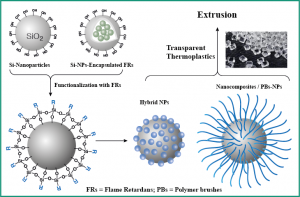HybridNanoFlam
Innovative flame retardant solutions based on polymer hybrid nanoparticles for transparent thermoplastic applications
In order to develop a tailor-made material from a transparent thermoplastic, an efficient flame retardant solution that is compatible with the plastic and also cost-effective is required. Toxicological safety and environmental compatibility are other criteria that flame retardants (FRs) must also meet. The most common FRs-additives today for thermoplastics are typically low-molecular halogenated organic compounds that are added to the polymer in appropriate quantities via extrusion or compounding. Some of these FRs have serious drawbacks, including poor compatibility with the plastic matrix, which can lead to microphase separation and thus clouding of the transparent plastic. Furthermore, a tendency to migration and thus to leaching from the plastic matrix, a tendency to discoloration and/or to odor formation, and even toxic, persistent and bio-accumulative environmental behavior are observed. Therefore, it is a major challenge for the current industrial researches, especially for manufacturers of polymer moldings or semi-finished products and compounding, to provide new solutions for the development of plastics formulations, especially for plastics in transparent applications such as automotive and aerospace. The economic importance of the development of such tailor-made material innovations is considered to be high, especially for the supplying polymer processing industry that is characteristic of domestic SMEs. New, more durable and efficient systems, which can be ideally processed with conventional machines in compounding and injection molding, give these companies a significant competitive advantage.
Polymeric hybrid silica nanoparticles (Si-NPs) are already widely used in composite materials for the improvement of the chemical, thermal and mechanical properties of plastics. Both commercially available silica particles and those produced in the laboratory using the Stöber process can be used. The surface functionalization of these particles can be achieved either by using suitable silanization reagents or by polymer grafting, which can be adapted to the respective polymer matrix. In addition to the surface functionalization with FRs, additional FRs additives could be also encapsulated into the particles (see the figure below).
The advantages of the hybrid nanoparticles produced in this way are the indispensable preservation of the thermoplastic transparency, the lack of migration tendency of the particles as well as the possibility of combining different functions of flame retardant resulting in a synergistic effect by means of a single dosage into the plastics. This enables the conversion into marketable products with high attractiveness. On a laboratory scale, the incorporation of the functional nanoparticles is realized by means of micro-extrusion and injection molding at Hamm-Lippstadt University of Applied Sciences.

Angaben zum Forschungsvorhaben:
Titel: Innovative Flammschutzlösungen auf Basis polymerer Hybridnanopartikel für transparente thermoplastische Kunststoffanwendungen. Kennwort: HybridNanoFlam Förderkennzeichen: DECHEMA IGF-Vorhaben-Nr. 22352 N Laufzeit: 01.03.2022 – 29.02.2025
Projektpartner:
Dr. Ralf Weberskirch Fakultät für Chemie und Chemische Biologie Otto-Hahn Str. 6 Technische Universität Dortmund D-44227 Dortmund https://ccb.tu-dortmund.de/en/professorships/oc/weberskirch/
Dr. Sabine Fuchs Chemie und Materialwissenschaften Hochschule Hamm-Lippstadt Dr.-Arnold-Hueck-Str. 3 D-59557 Lippstadt https://www.hshl.de/personen/prof-dr-sabine-fuchs
Thomas Mayer-Gall Arbeitsgruppenleiter Green Chemistry und Nanotechnologie Deutsches Textilforschungszentrum Nord-West gGmbH Adlerstr. 1 D-47798 Krefeld Kontakt DTNW: Dr. Thomas Mayer-Gall, Tel.: +49-2151-843-2015, E-Mail: mayer-gall@dtnw.de
Weitere Informationen zum Download:





